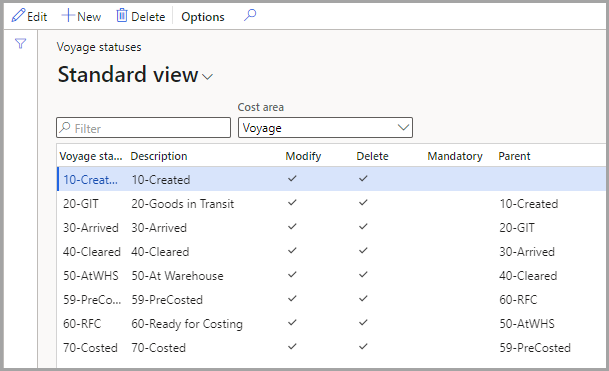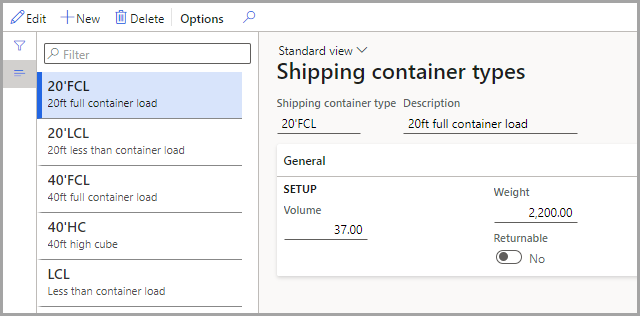Set up voyages and shipping containers
In this unit, you'll learn how to set up voyages and shipping containers.
Voyage status
The Voyage statuses page is where you'll define the set of status values that users can attribute to voyages. Users can assign voyage status values to every voyage level, including the voyage, shipping container, folio, purchase order, and item (purchase lines and transfer order lines). Voyage status values provide two functions:
Inform the user of the voyage status, shipping container, folio, purchase order, or items (purchase lines and transfer order lines).
Limit the cost area's use by restricting its modification or deletion.
To get started, go to Landed cost > Setup > Voyage statuses, where you can edit existing statuses, create new ones, or delete old ones by using the Action Pane buttons.
Each cost area has its own set of voyage statuses and hierarchies. As a result, you'll need to go to the Cost area field and select the area that you want to view, or you can create a new status. Then, for each voyage status, set the fields as follows.
| Field | Description |
|---|---|
| Voyage status | Enter the voyage status name. |
| Description | Enter the voyage status description. |
| Modify | Select the check box to allow users to modify voyages with this status. |
| Delete | Select the check box to allow users to delete voyages with this status. |
| Mandatory | Select the check box to make the voyage status mandatory, preventing it from being skipped. |
| Parent | Use this field to create a hierarchy among the status values. You can only modify voyage statuses downward in the hierarchy (manually or automatically) from a parent status to one of its child statuses. |
System events, such as rules that are set up through the tracking control center, can automatically modify the status of a voyage.
Note
You can only set up the voyage statuses that your company uses. Typical voyage statuses are: Confirmed, Goods in transit, Received, Prepared for costing, and Costed. However, other statuses might exist.
Shipping containers
To set up shipping containers, you first need to identify the various shipping container types that are available for use during shipping and voyages.
Go to Landed cost > Containers setup > Shipping container types to work with shipping container types. On this page, you can view, edit, create, and delete container type records. The following list describes the various fields on the page.
| Field | Description |
|---|---|
| Shipping container type | Enter a unique identifier for the shipping container type, such as a name or a number. |
| Description | Enter the shipping container type description. |
| Volume | Enter the maximum volume allowed. |
| Returnable | Indicate whether this type of shipping container might be returned to the seller following use on a voyage or not. If this option is set to Yes, additional charges for returning shipping containers of this type to their port of origin might apply. |
Shipping container records
Shipping container records identify each container that is used on a voyage. Therefore, when you create a voyage, you can choose a specific container from a list of all shipping container records that you've defined. This feature is especially beneficial if your business owns the shipping containers.
Shipping container numbers don't need to be included if the shipping container is used only once. Instead, you can add the shipping container number when you create the voyage.
Go to Landed cost > Containers setup > Shipping containers to work with shipping containers. On this page, you can view, edit, add, and delete records for your shipping containers. The following list describes the fields on the Shipping containers page.
| Field | Description |
|---|---|
| Shipping container | Enter a unique identifier for the shipping container. |
| Shipping container type | Select the shipping container type. For more information, go to the Set up shipping container types section in this unit. |
Note
Keep the following factors in mind before you set up shipping containers:
Shipping container records are used only for the Landed cost module. They are not included in the Transportation management module's standard functionality.
The shipping container configuration is optional. Typically, it's used if your organization owns its own shipping containers or frequently reuses the same shipping containers.
No check digits are calculated for shipping container numbers.
Set up unit types
Unit types place shipping containers into other groupings and methods of identification. In most cases, you can use the unit type to identify the container in which the goods are packaged, such as crates, pallets, or drums. When you create a container on the All shipping containers page, you can select a unit type.
Go to Landed cost > Container setup > Unit types, where you can view, edit, add, and delete various unit type records. Unit types have the following fields.
| Field | Description |
|---|---|
| Unit type | Enter a unique identifier for the unit type. |
| Description | Enter the unit type description. |
Set up refrigeration types
Like unit types, you can use refrigeration types to group and identify shipping containers (in other words, refrigeration containers).
Go to Landed cost > Container setup > Refrigeration types, where you can view, edit, add, and delete refrigeration type records. Refrigeration types involve the following fields.
| Field | Description |
|---|---|
| Refrigeration type | Enter a unique identifier for the refrigeration type. |
| Description | Enter the refrigeration type description. |

